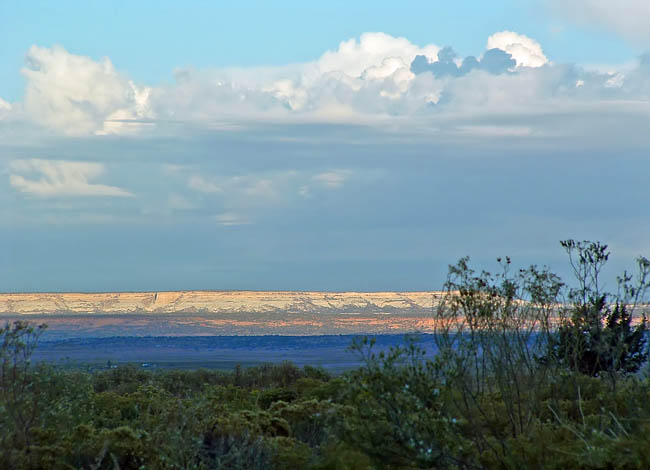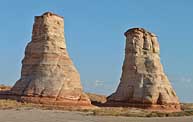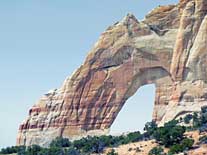|
Scenic USA - Arizona White Mesa |

| Photos by Ben Prepelka and Dr. Rob Jones |
The Colorado Plateau's sculpted beauty and the rich palette of earth-tone hues found in its rock layers have captured the hearts of countless photographers, back-country explorers and field geologists for over a century. Named by one of the first  learned explorers during the 1870s, (John Wesley Powell), the area has been the subject of study ever since. Taking in large sections of Utah, Arizona, New Mexico and bordering the Rocky Mountains in Colorado, the immense plateau covers 130,000 square miles. Only the states of Alaska, Texas, California and Montana are larger in area. What's most interesting about the plateau is how it has remained relatively unchanged for the last 500 to 600 million years. Aside from erosion, the huge basin has resisted being shaped by up-thrusts, volcanism and earthquakes, all common forces of geology found throughout the continent. Surrounded by volcanic highlands, the Colorado Plateau is actually huge ringed basin filled with many plateaus and immense deposits of sediment and windblown sand. Gradually sinking under this enormous weight of additional material, pressure compressed the deposits into many rock layers several miles thick.
learned explorers during the 1870s, (John Wesley Powell), the area has been the subject of study ever since. Taking in large sections of Utah, Arizona, New Mexico and bordering the Rocky Mountains in Colorado, the immense plateau covers 130,000 square miles. Only the states of Alaska, Texas, California and Montana are larger in area. What's most interesting about the plateau is how it has remained relatively unchanged for the last 500 to 600 million years. Aside from erosion, the huge basin has resisted being shaped by up-thrusts, volcanism and earthquakes, all common forces of geology found throughout the continent. Surrounded by volcanic highlands, the Colorado Plateau is actually huge ringed basin filled with many plateaus and immense deposits of sediment and windblown sand. Gradually sinking under this enormous weight of additional material, pressure compressed the deposits into many rock layers several miles thick.
While a great amount of evidence  has been exposed in the mile deep Grand Canyon, sites throughout the Four Corners Region exhibit this unique geology of sedimentary strata. Here, along Arizona's U.S. Route 160, sandstone layers (strata) vary from yellow, black, green, red, white and pink, depending on their age. While this photo is tinted by an early morning sunrise, the cliffs of White Mesa exhibit a layer of sandstone that has bonded with white limestone. The deposit, about 2300 feet thick, is thought to have originated in Canada and blown into the lowlands of the Colorado Plateau. A closer looks shows that erosion, brought on by wind, rain and frost, has carved out unique landforms into the sandstone. White Mesa Arch, found on the Navajo Reservation just north of Route 160, is a natural arch on the southern end of the mesa. With a vertical opening height of 85 feet and a span of 55 feet, this large arch may pique the curiosity of avid arch hunters. But leaving the highway and exploring this part of the country without a Native guide or permit is frowned upon by the Navajo.
has been exposed in the mile deep Grand Canyon, sites throughout the Four Corners Region exhibit this unique geology of sedimentary strata. Here, along Arizona's U.S. Route 160, sandstone layers (strata) vary from yellow, black, green, red, white and pink, depending on their age. While this photo is tinted by an early morning sunrise, the cliffs of White Mesa exhibit a layer of sandstone that has bonded with white limestone. The deposit, about 2300 feet thick, is thought to have originated in Canada and blown into the lowlands of the Colorado Plateau. A closer looks shows that erosion, brought on by wind, rain and frost, has carved out unique landforms into the sandstone. White Mesa Arch, found on the Navajo Reservation just north of Route 160, is a natural arch on the southern end of the mesa. With a vertical opening height of 85 feet and a span of 55 feet, this large arch may pique the curiosity of avid arch hunters. But leaving the highway and exploring this part of the country without a Native guide or permit is frowned upon by the Navajo.
Area Map

|
Other Area Attractions |
|
Copyright © 2023 Benjamin Prepelka
All Rights Reserved
